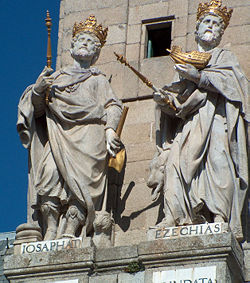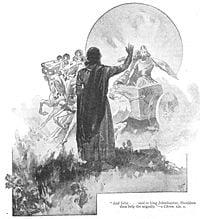Difference between revisions of "Jehoshaphat" - New World Encyclopedia
m |
m |
||
| Line 4: | Line 4: | ||
'''Jehoshaphat'''—also speled '''Jehosaphat''' or '''Yehoshafat''' ('''יְהוֹשָׁפָט''' "[[Tetragrammaton|Jehovah]] is judge," Hebrew '''{{Unicode|Yəhošafat}}''')—was the son and successor of [[Asa of Judah|Asa]], king of [[Kingdom of Judah|Judah]]. [[William F. Albright]] has dated the reign of Jehoshaphat to 873 B.C.E.-849 B.C.E., while [[E. R. Thiele]] offers the dates 870 B.C.E.-848 B.C.E. His mother's name was Azubah, daughter of Shilhi. | '''Jehoshaphat'''—also speled '''Jehosaphat''' or '''Yehoshafat''' ('''יְהוֹשָׁפָט''' "[[Tetragrammaton|Jehovah]] is judge," Hebrew '''{{Unicode|Yəhošafat}}''')—was the son and successor of [[Asa of Judah|Asa]], king of [[Kingdom of Judah|Judah]]. [[William F. Albright]] has dated the reign of Jehoshaphat to 873 B.C.E.-849 B.C.E., while [[E. R. Thiele]] offers the dates 870 B.C.E.-848 B.C.E. His mother's name was Azubah, daughter of Shilhi. | ||
| − | One of the "good" kings in the [[Bible]], he was a descendant of King [[David]]. His immediate successor was his son [[Jehoram of Judah]], and his descendants continued to rule in Jerusalem until the [[Babylonian exile]]. Jehoshaphat pursued a policy of cooperation with the northern [[Kingdom of Judah]] that was generally successful externally, | + | One of the "good" kings in the [[Bible]], he was a descendant of King [[David]]. His immediate successor was his son [[Jehoram of Judah]], and his descendants continued to rule in Jerusalem until the [[Babylonian exile]]. His reign was a prosperous one. He instituted legal reforms and strengthen the administrative apparatus of the state. In foreign affairs Jehoshaphat pursued a policy of peace and cooperation with the northern [[Kingdom of Judah]] that was generally successful externally. He retained former territories in Israel captured by Asa, helped Israel defeat its eastern enemies, and maintained Judah's dominance over the neighboring nation of Edom. However, his support of Israel's king [[Ahab]] brought the condemnation of at least one [[prophet]]. |
| + | |||
| + | On the other hand, Jehoshaphat strongly promoted with worship of [[Yahweh]], improved the Temple of Jerusalem, and repressed pagan religion, earning him praise from the biblical writers as one who "walked in the ways of his father David." In Christian tradition, he is listed in the genealogy of Matthew 1:8 as one of the ancestors of [[Jesus]]. | ||
Revision as of 06:04, 18 April 2007

Jehoshaphat—also speled Jehosaphat or Yehoshafat (יְהוֹשָׁפָט "Jehovah is judge," Hebrew Yəhošafat)—was the son and successor of Asa, king of Judah. William F. Albright has dated the reign of Jehoshaphat to 873 B.C.E.-849 B.C.E., while E. R. Thiele offers the dates 870 B.C.E.-848 B.C.E. His mother's name was Azubah, daughter of Shilhi.
One of the "good" kings in the Bible, he was a descendant of King David. His immediate successor was his son Jehoram of Judah, and his descendants continued to rule in Jerusalem until the Babylonian exile. His reign was a prosperous one. He instituted legal reforms and strengthen the administrative apparatus of the state. In foreign affairs Jehoshaphat pursued a policy of peace and cooperation with the northern Kingdom of Judah that was generally successful externally. He retained former territories in Israel captured by Asa, helped Israel defeat its eastern enemies, and maintained Judah's dominance over the neighboring nation of Edom. However, his support of Israel's king Ahab brought the condemnation of at least one prophet.
On the other hand, Jehoshaphat strongly promoted with worship of Yahweh, improved the Temple of Jerusalem, and repressed pagan religion, earning him praise from the biblical writers as one who "walked in the ways of his father David." In Christian tradition, he is listed in the genealogy of Matthew 1:8 as one of the ancestors of Jesus.
Reign
Ascending the throne at the age of 35 years (1 Kings 22:42) Jehoshaphat spent his first regnal years fortifying his northern cities against a possible attack from the Israel (2 Chron. 17:1, 2) which his father, Asa, had captured earlier. He reprotedly refrained from "consulting the Baals" and destroyed sacred pillars dedicated to the goddess Ashera. (2 Chron 17:2-6) 1 Kings 22:43 disagrees with Chronicles as to whether he removed unauthorized altars located at varioushigh places. Chronicles, taking the more approving view, reports that in the third year of his reign he sent out priests and Levites over the land to instruct the people in the Law (2 Chr. 17:7-9). He also solidified his monarchy's administrative apparatus and greatly enriched Judah's treasury.
Alliance with Ahab
Having thus strengthened his domistic situation, Jehoshaphat persued a diplomatic policy of peace with the northern kingdom, allying with Israel against Syria, Moab, and Ammon. Judah was the weaker partner in this alliance, due to Israel's superior resources and its better access to Meditarreanian trade.
In the third year of his reign Jehosaphat traveled to the northern capital to meet with King Ahab of Israel. In addition to military and trade agreements, Jehosphat married his son Jehoram of Judah to Ahab's daughter Athaliah, who would later rule as Queen of Judah. A key ingredient in the alliance was Jehoshaphat's agreement to join Ahab against the Syrian king Ben-Hadad in the battle of Ramoth-Gilead. The biblical writers are ambivalent as to whether this alliance was inspired by God. Ahab had previously received prophetic support in battles against Beh-Haded, but was strongly denounced by Elijah for supporting Baal worship. '1 Kings' 22:1-33 describes 100 prophets of Yahweh approving the plan to march against Ben-Hadad, against one dissenting voice voice, that of Micaiah Ben Imlah. Yet even Micaiah admits that God wants Ahab to attack the Syrians, for it is God's plan that Ahab be defeated. Jehoshaphat fights bravely at Ahab's side in full kingly regalia, while Ahab disguises himself as a common charioteer.

Ahab, neverless, is killed, while Jehoshaphat safely returns from this battle. Back in Jerusalem, the king is confronted by the prophet Jehu, son of Hanni, (2 Chr. 19:1-3)—not to be confused with the Jehu who later reign in Israel—who reproached him for this alliance.
- Should you help the wicked and love those who hate the Lord? Because of this, the wrath of the Lord is upon you.
God's wrath does not seem to do the king any harm, however, as we are told immediately that Jehoshaphat "turned back to the Lord."
He also carried out a significant judicial reform, appointing judges throughout the land and ordering them: "Consider carefully what you do, because you are not judging for man but for the Lord... There is no injustice or partiality or bribery." (2 Chron. 19:6-7) He also strengthened the system of religious law centering on the Temple of Jerusalem by appointing Levites, priests, and clan heads to administer justice there.
Continued alliance with Israel
Jehoshaphat also entered into an alliance with Ahab's son Ahaziah of Israel, for the purpose of carrying on maritime commerce with Ophir. However, the fleet that was equipped at Ezion-Gever was wrecked. A new fleet was fitted out without the cooperation of the king of Israel, and although it was successful, the trade was not prosecuted (2 Chr. 20:35-37; 1 Kings 22:48-49).
When Ahaziah died, Jehoshaphat joined Jehoram, king of Israel, in a war against the Moabites, who were under tribute to Israel. This effort received the grudging approval of the prophet Elisha, and was successful. The Moabites were subdued, but upon seeing Mesha's act of offering his own son in a human sacrifice on the walls of Kir-haresheth Jehoshaphat was filled with dread, and he withdrew to his own land (2 Kings 3:4-27).
Defeating the Edomite confederacy
Throughout Jehosphat's reign, Judah maintain a position of superiority over the country of Edom. Judah also helped Israel maintain its position of superiority against it vassals, Ammon and Moab. The last notable event of Jehoshaphat's reign occurred when a powerful coalition of Edomites, together with Ammonite and Moabite allies, rebelled against his rule. (2 Chr. 20) The allied forces were encamped at Ein Gedi. The king and his people were filled with alarm. Jehoshaphat prayed in the new court of the Temple, which he had financed. Amid the silence that followed, the prophetic voice of Jahaziel the Levite was heard announcing that the next day all this invading host would be overthrown. The Bible reports that the attacker coalition broke down and they began fighting violently among themselves, the Ammonites and Moabites against the "men of Mount Seir" (Edomites). Many Edomites were slain in the battle, leaving to the people of Judah only to gather the rich spoils of the slain: "There was so much plunder that it took three days to collect it." (2 Chron. 20:25) Soon after this victory Jehoshaphat died after a reign of twenty-five years at the age of sixty (1 Kings 22:50).
Legacy
Like his ancestor, King David, Jehoshaphat's family faced trouble, division, and bitter intrigue. His son Jehoram of Judah was married to Athaliah, the daughter of King Ahab and Queen Jezebel of Israel. To solidify his rule, Jehoram reportedly killed all of Jehoshaphat's other children and pursued a policy of toleration toward pagan religions. To make matters worse, under Jehoram, Edom successfully revolted, and Judah was forced to acknowledge their independence. Later, a raid consisting of Philistines, Arabs and Ethiopians looted the king's house and carried off all of his family except for his youngest son Ahaziah of Judah, also called Jehoahaz. (2 Chron. 21:16f) Like his grandfather, Ahaziah allied with Israel against Syria. However, he was killed during a bloody purge of the house of Ahab by the divine-approved usurper Jehu. This left Jehoram's wife Athaliah, Ahab's daughter, in a position to seize the the throne in Jerusalem, where she conducted a bloodbath of her own. After six years, she was killed in a counter-coup orchestrated by the priests of the Temple of Jerusalem, who placed their young protege, Athaliah's grandson Jehoash, on the throne. The drama had now come full circle, as Jehoash, under the tutlelage of the priests, returned—albeit temporaily—to the Yahweh-only policy of his great-grandfather Jehosaphat.
As a king of the Davidic line, Jehosophat's descendants continued to reign in Jerusalem under the Babylonian exile. In Christian tradition, he is one of those listed as an ancestor of Jesus in the genealogy of Matthew 1:8.
| Preceded by: Asa |
King of Judah Albright: 873 B.C.E. – 849 B.C.E. Thiele: c.870 B.C.E. – 848 B.C.E. Galil: c.870 B.C.E. – 845 B.C.E. |
Succeeded by: Jehoram |
ReferencesISBN links support NWE through referral fees
- Jewish Encyclopedia: "Jehoshaphat"
Credits
New World Encyclopedia writers and editors rewrote and completed the Wikipedia article in accordance with New World Encyclopedia standards. This article abides by terms of the Creative Commons CC-by-sa 3.0 License (CC-by-sa), which may be used and disseminated with proper attribution. Credit is due under the terms of this license that can reference both the New World Encyclopedia contributors and the selfless volunteer contributors of the Wikimedia Foundation. To cite this article click here for a list of acceptable citing formats.The history of earlier contributions by wikipedians is accessible to researchers here:
The history of this article since it was imported to New World Encyclopedia:
Note: Some restrictions may apply to use of individual images which are separately licensed.